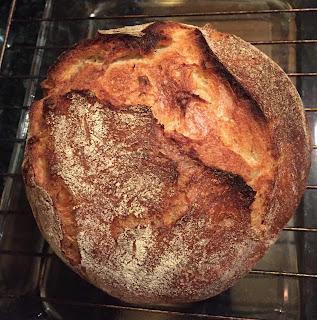Grape Success!

I have a large list of experimental brewing experiments I'd like to try. Brewing is an ideal hobby in that it serves well two hobby-elements that I value: 1) The progressive honing of a craft 2) Pure Experimentation. A lot of brewers ardently pursue the refinement of their skill as craftsmen, that brewing success comes in the pursuit of a finely formulated Pilsner. I think that's great - but experimentation is the other side that is even more exciting: wouldn't you too like to know what a fermented Altoids-slurry tastes like?
Some of my experiments are more out there (Altoids-slurry) than others (hard root beer). Hard fruit juices seem like a pretty obvious thing to try, and there are plenty of fruit options. We chose a pretty softball one at first: Grape-Cranberry. We did a total of 192 ounces (1.5 gallons), one gallon Whole-Foods Grape juice and one-half gallon Whole Food Cranberry. We gussied that up, or chaptalized, it with 720 grams of glucose. I tossed that with a packet of Lalvin EC-118 (somewhat generic French wine yeast) and let it go for two weeks.
After fermenting, it was naturally quite dry, and the cranberry is somewhat tart and astringent. We needed to sweeten it, but one problem with sweetening things that will be bottle-conditioned is that you can't with normal sugars because any residual sugar will be eaten by the yeast, carbon dioxide will be generated - and if there is enough in there, the bottle will explode (it's happened to me, and it's really quite dangerous - that's for another blog post). So, to sweeten, we need a non-fermentable sweetener like the Roman's sugar of lead (too brain-damagey), Cyclamate (too cancery), Aspartame (too Aspartamey), wonder-sugar (too made up), and finally the answer: stevia (awesome).
Stevia is powerful stuff. I bought ten grams of pure uncut Stevia at Whole Foods, which the label claims has 300x the perceived sweetness of table sugar. We gradually (by 1/8 tsps) added Stevia to the mixture until we got the right balance: at 3/8 tsp for nearly two gallons of liquid (volume including the added priming sugar mixture).
The end result is still slightly tart and astringent (which would have been overpowering without the stevia), but with a great grapey, red-winey flavor. I think it'll be great sitting in the warm spring sun, over ice (the beverage, not sitting arrangement). The cranberry definitely took a backseat in flavor, so I'd say it's worth trying an all-cranberry one, now that we know we can use stevia to solve our sweetness problem. Next stop: hard lemonade.

Seriously! Chris! The market potential of this product is huge. Why haven't we invested in industrial equipment and looked for bulk discounts on the juice? Also, pull down this post! It's giving away precious IP!
ReplyDelete